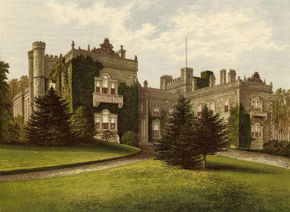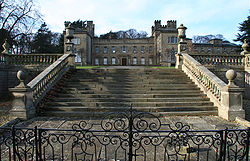
Aske Hall
Encyclopedia


Georgian architecture
Georgian architecture is the name given in most English-speaking countries to the set of architectural styles current between 1720 and 1840. It is eponymous for the first four British monarchs of the House of Hanover—George I of Great Britain, George II of Great Britain, George III of the United...
country house
English country house
The English country house is a large house or mansion in the English countryside. Such houses were often owned by individuals who also owned a London house. This allowed to them to spend time in the country and in the city—hence, for these people, the term distinguished between town and country...
, with parkland attributed to Capability Brown
Capability Brown
Lancelot Brown , more commonly known as Capability Brown, was an English landscape architect. He is remembered as "the last of the great English eighteenth-century artists to be accorded his due", and "England's greatest gardener". He designed over 170 parks, many of which still endure...
, 1.5 miles (2.4 km) north of Richmond
Richmond, North Yorkshire
Richmond is a market town and civil parish on the River Swale in North Yorkshire, England and is the administrative centre of the district of Richmondshire. It is situated on the edge of the Yorkshire Dales National Park, and serves as the Park's main tourist centre...
, North Yorkshire
North Yorkshire
North Yorkshire is a non-metropolitan or shire county located in the Yorkshire and the Humber region of England, and a ceremonial county primarily in that region but partly in North East England. Created in 1974 by the Local Government Act 1972 it covers an area of , making it the largest...
, England
England
England is a country that is part of the United Kingdom. It shares land borders with Scotland to the north and Wales to the west; the Irish Sea is to the north west, the Celtic Sea to the south west, with the North Sea to the east and the English Channel to the south separating it from continental...
. It contains an impressive collection of 18th-century furniture, paintings and porcelain, and in its grounds a John Carr stable block converted into a chapel in Victorian times with Italianate decor, a Gothic-style folly built by Daniel Garrett
Daniel Garrett
Daniel Garrett was a British architect who worked on the Burlington Estate, Culloden Tower,, Raby Castle, and Banqueting House.-History:Garrett started as a clerk of works, then in 1735 set up his own practice in the North of England...
circa 1745, coach house with carriage, Victorian stable block, walled garden, terraced garden, and lake with a Roman-style temple. The hall and estate are currently owned by the Marquess of Zetland
Marquess of Zetland
Marquess of Zetland is a title in the Peerage of the United Kingdom. It was created on 22 August 1892 for the former Lord Lieutenant of Ireland, Lawrence Dundas, 3rd Earl of Zetland. Zetland is an archaic spelling of Shetland. The Dundas family descends from the wealthy Scottish businessman and...
.
It is a place of some antiquity, and long the de Aske family residence, but at first consisted merely of a square tower surrounded by bare and swampy fields. In this state it remained until it was purchased, in the year 1727, by Sir Conyers D'Arcy, who commenced those improvements which have now rendered it one of the finest country seats in the neighbourhood. There is an extensive prospect over the surrounding landscape from the top of the Temple, which is built on the exact model of a Hindoo Temple. On Pilmore Hill (between Aske and Richmond) is a Tower bearing the grotesque name of Olliver Ducat, which is said to be a perfect counterpart of an Indian Hill-Fort.
Aske Hall's history has been well documented, notably in Richmond Architecture and in a two-part article by Giles Worsley
Giles Worsley
Dr Giles Arthington Worsley MA, PhD, FSA was an English architectural historian, author, editor, journalist and critic, specialising in British country houses...
published in Country Life
Country Life (magazine)
Country Life is a British weekly magazine, based in London at 110 Southwark Street, and owned by IPC Media, a Time Warner subsidiary.- Topics :The magazine covers the pleasures and joys of rural life, as well as the concerns of rural people...
in March 1990. The following description has been derived from these texts.
With the exception of the pele tower, which dates from the 12th century, the earliest surviving sections of Aske Hall were constructed in the 15th century by the medieval family of de Aske. In 1578, Robert and Eleanor Bowes added a lofty manorial hall, two storeys high internally, with a frieze about a metre high of allegorical figures with foliage in bas-relief, designed to be enjoyed from ground level. A section of this frieze has survived the many subsequent phases of alterations.
In 1722, Sir Conyers Darcy
Conyers Darcy
Sir Conyers Darcy or Darcey, KB was a British politician and courtier of the 18th century. He was a younger brother of Robert Darcy, 3rd Earl of Holderness....
acquired a house which had been neglected for the best part of a century, and he commenced his improvements in 1727. Some idea of the improvements which he carried out may be had from a survey of the estate lodged with the Dundas Papers at the North Yorkshire Record Office at Northallerton
Northallerton
Northallerton is an affluent market town and civil parish in the Hambleton district of North Yorkshire, England. It lies in the Vale of Mowbray and at the northern end of the Vale of York. It has a population of 15,741 according to the 2001 census...
. This survey shows that Darcy "swept away the complex roofing [except the towers] removed the porch and the projecting blocks in the corners of the wings and completely refenestrated the house". The architect for these changes appears to have been William Wakefield
William Wakefield
William Hayward Wakefield was an English colonel, the leader of the first colonizing expedition to New Zealand and one of the founders of Wellington. In 1826, he married Emily Sidney, a daughter of Sir John Sidney.-Early life:...
. Darcy also remodelled Aske's somewhat swampy setting, creating the lake, the temple [1740 by Daniel Garrett] and a large "Gothick" garden building to the north of the Hall.
In 1763, Sir Lawrence Dundas purchased the house for £45,000. In partnership with his architect, John Carr, Dundas sought to transform Aske Hall into one of the great 18th-century houses of the North, "a fitting monument" and pendant to a man who was himself known as "the Nabob of the North". The newly refurbished Aske was to furnish him with a "suitable seat for a new dynasty and a controlling influence in the parliamentary borough of Richmond". Initially, work was concentrated on completing the offices, stables, bakehouse, wash-house and laundry. The Dundas Papers also record that Carr demolished the rear section of the dwelling, while leaving the hall range and wings intact. According to Giles Worsley: "In its place, grouped round an open courtyard, was built a new kitchen, scullery and a range of servants' rooms, including a steward's parlour, a housekeeper's room and a strong room, together with family rooms and a staircase."

Ignatius Bonomi
Ignatius Bonomi was an English architect and surveyor, with Italian origins by his father, strongly associated with Durham in north-east England....
." Bonomi was probably also responsible for one of the west lodges, which is dated 1847.
Aske Hall appeared as the background in early Ted & Ralph scenes of the TV series The Fast Show
The Fast Show
The Fast Show, known as Brilliant in the US, was a BBC comedy sketch show programme that ran for three series from 1994 to 1997 with a special Last Fast Show Ever in 2000. The show's central performers were Paul Whitehouse, Charlie Higson, Simon Day, Mark Williams, John Thomson, Arabella Weir and...
.
The house is a Grade I listed building. It is open to the public (for guided tours only) on a very limited number of days per year.

